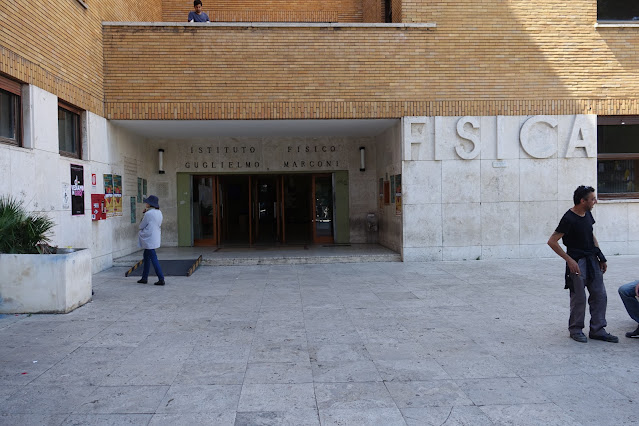Traces of Enrico Fermi, one of the world's greatest theoretical physicists, are visible in Rome, the city of his birth and where he was driven out by Fascism.
Fermi, an acknowledged prodigy in math and science, started his work on a street now more known for its night-life, via Panisperna in the Monti quarter. He and his associates were dubbed "I ragazzi di via Panisperna," - "the boys of via Panisperna," and are captured in the photo below:
Enrico Fermi at far right. The
other "ragazzi"
from left to right, Oscar D'Agostino,
Emilio Segrè, Edoardo Amaldi,
and Franco Rasetti. The photo
was taken by a sixth, Bruno Pontecorvo.
The background looks very much
like the buildings on via Panisperna
today, though #90, where the institute
supposedly was, is an older church.
As a result, we are not sure exactly where on
via Panisperna the institute was located.
Fermi's location beginning in 1935 is well-known, and now bears his name, as well as sporting a plaque commemorating his extraordinary research there. And that's in the main campus of Rome's storied university, La Sapienza, or La Città Universitaria, designed by Mario Piacentini and opened in 1935 (the subject of prior posts, including one on Gio Ponti's math building and another on Mario Sironi's "Aula Magna" mural - Great Hall - painted in 1935).
In May 2018 we joined a guided tour of the University's physics department, located in one of Piacentini's original set of buildings.
Left, the Department of Physics is named for Fermi.
The Physics Institute itself is named for another Nobel-winning Italian physicist (and member of the Fascist Party, as was Fermi at one point), Guglielmo Marconi, as seen here:
The plaque below - inside the building - reads:
"In this institute from 1927 to 1938 Enrico Fermi taught and studied. Here he investigated the structure of materials and discovered the radioactivity caused by neutrons [actually neutrinos], opening new avenues in the world. To the knowledge and power of man." [As noted, the institute was located on via Panisperna until about 1935.]
What the plaque does not say is that in 1938, when Fermi, age 37, went to Stockholm to accept his Nobel prize in physics, he kept going - to the United States, fleeing with his family from the racial laws of Italy that had already affected the lives of many of his colleagues and potentially would affect his wife, who was of Jewish heritage.
The tour included parts of Fermi's lab (left), and a cabinet of Fermi tools and books (below, right).
Besides the photo of i ragazzi di via Panisperna, other photos on display on the tour included the one below of Fermi with two other giants of theoretical physics, Werner Heisenberg and another Italian, Wolfgang Pauli (below, the German Heisenberg in the center, Pauli on the right), at Lake Como (date unclear).
The Nobel Prize website has a good biography of Fermi and lay-person descriptions of his scientific breakthroughs (at least one of which was developed based on Pauli's research).
Dianne







